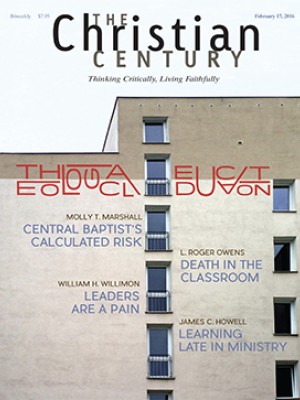Howard Divinity School returns sacred manuscript to Ethiopian monastery
A delegation from Howard University Divinity School has returned an ancient manuscript to an Ethiopian monastery after scholars discovered its place of origin.
The manuscript contains two texts, the Acts of Paul and the Acts of Serabamon, and is part of one of the largest collections of Ethiopian sacred artifacts in the United States. The manuscript was owned by the late André Tweed, a psychiatrist and Howard alumnus, who donated it in 1993.
Alton B. Pollard III, the school’s dean, said the manuscript was returned to the Debre Libanos monastery, which is about two hours away from Addis Ababa, Ethiopia’s capital. Several thousand spectators were on hand as dignitaries formally received the manuscript, which will be housed in a glass case and available for the public to touch once a year on January 11, the date of its return, he said.
Read our latest issue or browse back issues.
Pollard said the centuries-old books are sacred to the Ethiopian Orthodox Church and are distinct from the book of Acts in the New Testament. They describe the work and life of the apostle Paul and the lesser-known story of Serabamon, a martyred bishop in the early church who was named a saint.
The manuscript dates to the 15th century. It formed part of a larger collection housed at Howard’s divinity school intended to connect “peoples of African descent the world over with Christianity as a religion of African peoples well prior to the trauma caused by the mass enslavement and colonization of Africa’s people,” Pollard said.
Gay Byron, a New Testament and early Christianity expert at the divinity school, was one of the first to recognize that the document should be returned, but it took years to pinpoint its exact place of origin. The discovery was made in the cataloging process after the manuscript was digitized.
Steve Delamarter of George Fox Evangelical Seminary, another researcher involved in the process of returning the manuscript, said it is one of the oldest surviving Ethiopian manuscripts and especially meaningful for the Ethiopian Orthodox Church.
“Their artifacts are, for them, enormously significant, and there’s been a few such cases where institutions outside of Ethiopia have returned things to them and they’ve been enormously grateful for that,” said Delamarter, director of the Ethiopian Manuscript Imaging Project, who joined the Howard scholars in Ethiopia.
He said the Tweed manuscript had been ordered by the 15th-century abbot of the monastery, who was the indigenous leader of the Ethiopian Orthodox Church at the time.
“They’re very, very rare works,” he said. “I don’t know of any other manuscripts that contain these two apocryphal Acts of Paul and Serabamon.”
Howard delegation members hope their visit to Ethiopia will encourage others to return sacred documents to their original sites.
“With all due institutional integrity, we wanted to set an example for other schools, museums, and institutions around this country and even throughout the world for what it means to have rare manuscripts actually in their rightful home of origin,” Byron said.
In recent years, Delamarter has helped turn over a psalter that was once owned by an Ethiopian emperor to a museum in the East African country and a book of the four Christian Gospels once used by an Ethiopian empress to the patriarch of the Ethiopian Orthodox Church. —Religion News Service
This article was edited on February 2, 2016.





